Content marketing has long been an unavoidable term in (online) marketing and communication. The many training courses and articles illustrate that there is still much to learn and discover. This also applies to the determination of success: when do you have compelling content? Moreover, when can a blog, e-mail or social media message be called successful? There are many answers to that. In this article, I will take you into the statistics of Facebook, so that you can make your content efforts (organic and promoted) measurable.
In my work and training on social media analytics, I deal with all social media channels. Facebook is the platform that releases the most insights and statistics by far (in addition to YouTube, if you include that as social media). Unfortunately, Instagram, Twitter, and LinkedIn are far behind in this area.
There is something for everyone in Facebook’s statistics. From absolute beginner to seasoned expert. In this article I distinguish five ways to get your Facebook page, accompanying content and target group insightful. I do not include Facebook advertising via the Ads Manager (Business Manager), but we do include promoted messages (boosted posts).
1. Facebook Insights
The most basic way to find out everything about your page, messages and target audience are the Facebook Insights. As administrator of a Facebook page, you will find the ‘Insights’ tab at the top of the screen.
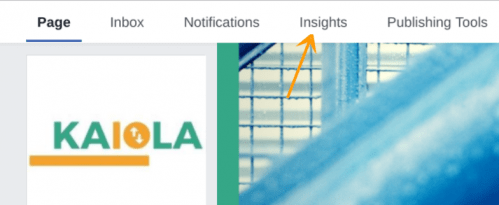
This is the place to monitor how your page and content perform and who your target audience is. You will find here all information and statistics about:
- Page likes. The development and size of your fanbase.
- Range. Statistics about the range of your own page posts and messages from others about your page.
- Positive and negative user actions. At Reach (reach) you will find information about the number of positive actions (likes, comments, reactions, shares, etc.) and negative actions (spam notifications, hiding messages and unlikes) by users.
- Pageviews. The number of times your page has been viewed and the origin of these visits.
- Posts. All information about your page posts. This list of messages can be filtered, modified and deepened per message by clicking on the message. Then you get more statistics about the specific message.
- Promotions. Promoted messages and the results of this paid distribution.
- Videos. A separate part of the statistics focused on video messages.
- People. Statistics about your fans and other people reached on your page and page posts.
- Messages. Insights in chat messages with your fans and target audience.
Here you will find even more important information, depending on your type of organization and objective, such as statistics about events, sources (how did you get to the page), page previews (mouse-overs in the newsfeed), shop statistics (if you have a Facebook shop) and branded content (if you have collaborations with influencers).
Possibilities and limitations
You can entertain yourself for a while in these statistics because there is quite a lot to be found. Take a look at your page messages and click on a message. You will see that a window opens with more statistics. Here you will also find your second-degree range because you can see what happens to the shared messages (shares) of your page. You recognize a real ‘viral message’ because there are many shares-on-shares; shared messages that are shared again.
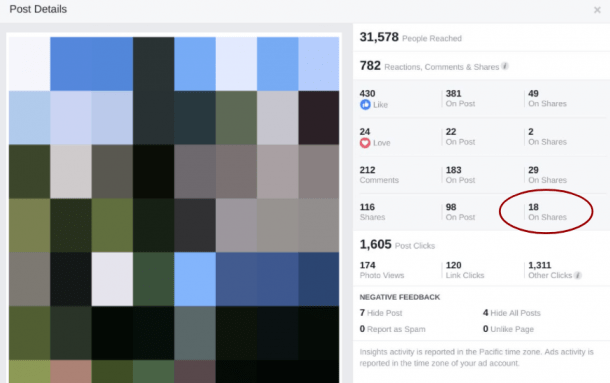
However, the Insights module also has its limitations. You can go back in your statistics for up to two years (then charts are unreadable), not all tables can be sorted, and you can not make your own calculations. However, these limitations can be circumvented by using the (somewhat tricky to find) export button.
2. Facebook Insights Exports
Have you ever made an export of the statistics from your Facebook page? I often hear the same reaction to those who have already done this. Usually, something that ‘can not see the forest through the trees’ or ‘I did not even start it.’ It is indeed quite overwhelming, the exports that Facebook offers you. However, there is a way to make this useful and ‘manageable.’

In the options you get when you click on ‘Export Data’ in your Facebook Insights, you see the following options:

Here it is soon apparent that three exports can be made, namely Page data, Post data and Video data. The latter option contains no new data compared to the other two but is only a clustering of data around video content.
At the top of the screen, you see the message that you can export a maximum of 500 messages (for the Post data) at a time. Also, it is also not possible to export a period longer than 180 days. Below the date range, you can still see the possibility to export as an Excel document (XLS) or CSV file.
Your own layout
Moreover, then the most important option: Layout. If you leave this option untouched, you will receive a sample of a document. Columns that go on and that cannot be recognized as data that you could do something with. The golden tip here is to choose ‘Make New Custom Layout.’ As you can see in the screenshot below of my Insights, it is possible to save it to use as a template again at a later date.
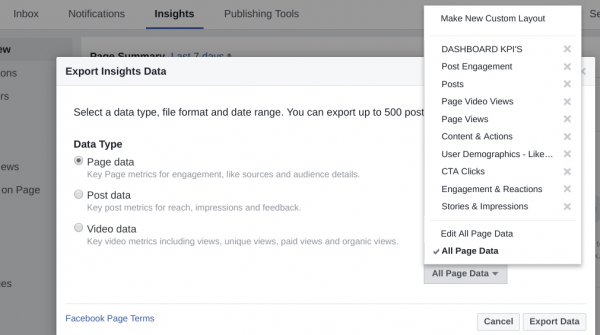
If you choose to create a new layout, you will see all possible options. Most options are clear, but some have a vague description or appear to be double. What data do you want to see? That depends on what is important to you. To find out which data you find exciting or important, I have exported all data and sorted out what you actually see. Entirely a monk works, but then you do not have to do it yourself anymore. You can find the complete list here.
Choose essential metrics here, save them in a Custom Layout and export multiple files (due to the maximum number of messages and days per export) and add them together in Excel or Google Spreadsheets.
I choose to paste the data into two tabs (Page Data and Post Data) in a spreadsheet, to create a Dashboard in another tab that retrieves the data from the tabs and displays it visually. This dashboard is then automatically updated when you add (later) new data, for example, if you want to view your progress every month. Such a dashboard can look like this:
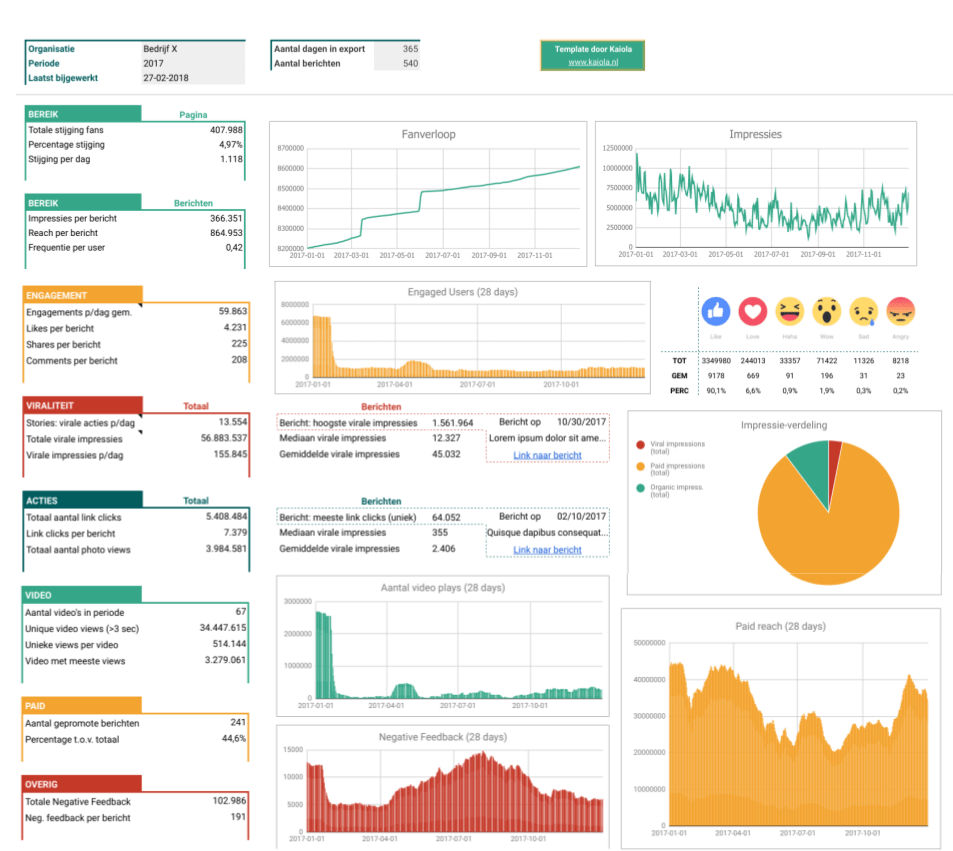
Click here for a more extensive format: Facebook Insights Export Dashboard – example (pdf).
For me and my customers, this works well because you spend much time with your export (because of the pre-set layout you create in Facebook Insights) and just place it in your tabs with data. The dashboard then automatically adjusts when you use a formula that counts the number of lines (number of messages and date range). A dashboard is an ideal way to make the data that you extract from your export transparent and comprehensible.
Possibilities and limitations
The possibilities are almost endless if you can not be put off by the many information that you can analyze. Choose the right variables and start using them. The downside of exports is that you are not sure what each variable means, because Facebook is not clear enough about this. That is easily solved: do not use those variables to measure and send. Moreover, look again at my overview.
3. Facebook Analytics
The terms Insights and Analytics are often confused, but when it comes to Facebook, they are really two completely different data sources. You can find Facebook Analytics on facebook.com/analytics if you are logged in on Facebook, and you manage a page.
What is it exactly? The power of Facebook Analytics lies in combining website statistics with your Facebook page, Messenger account, and any smartphone apps. To make use of this, it is necessary that you have implemented the Facebook Pixel on your website. This is the basis of the statistics of your website. This works the same as the code you need to implement Google Analytics on your site. If you do not have this yet, go and arrange it and watch this demo account in the meantime.
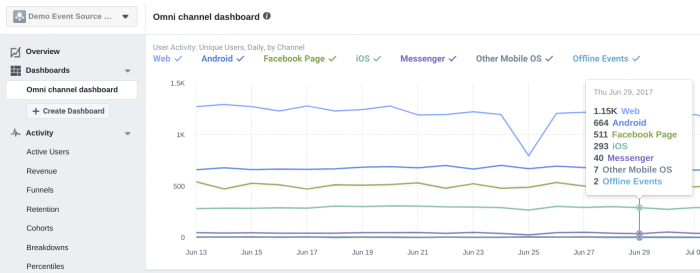
In your Business Manager, you create an Event Source Group, where you link your Facebook page, pixel and possibly your Messenger account and iOS / Android apps.
What can be analyzed next?
- Target group overlap. How many percents of your Facebook fans also visit your website? Moreover, how many website visitors have a Messenger conversation with you?
- Funnels. How many people arrive on your website and leave a response to your Facebook page within an hour? How many people buy a product on your website within three days after they have liked a Facebook message? Moreover, how many people visit a specific webpage after they have had a conversation with your Messenger bot?
- Retention. How many percents of your page visitors are still actively involved a month later? Moreover, how is that compared to your website visitors?
- Everything about website traffic. A lot of what you find in Google Analytics can also be found here. Information about who your visitors are, where they come from and what they deliver in your webshop, are available.
Possibilities and limitations
Facebook Analytics is absolutely a strong tool. It is not a replacement for Facebook Insights but gives an extra layer of information. If you have a webshop or customer service is an integral part of your business, then Facebook Analytics can give you additional insights about the role of Facebook in (purchase) behavior on your website and the influence of Messenger conversations on your page and website.
Because Facebook Analytics combines the data from different sources, it provides more cross-channel information than Google Analytics. It takes some time to make it your own and to set the right funnels and variables. What I miss is the link with Instagram as a source. Hopefully, this will be added in the future.
4. Use the Facebook APIs
With Facebook Insights (and associated export options) and Facebook Analytics, the platform already offers two options for showing and analyzing your data. If you want to go one step further, you can get started with the Facebook APIs, for example, to integrate it with your internal software or self-built tools. It goes too far to discuss the possibilities in this blog, but if you work with a larger organization with tools in-house, then this is an option to consider.
5. Choose from the many hundreds of social media tools
You do not have to invent the wheel yourself. There are many tools that collect and organize the data from your Facebook, Instagram, Messenger and other social media channels. Often these are paid tools and the most famous are originally American. Some examples:
- UnionMetrics. Gives your Facebook data a nice visual sauce. You can compare with the competition and see what times you can best post a message for most interaction. You will also receive advice based on your own historical data. For example, which hashtags provide more interaction than average and when you can expect the newest fans. A paid tool.
- Quintly. This is a relatively expensive tool, but the possibilities do not lie either. Are you a lot busy with content on Facebook and you want to go a step deeper, then this is a useful tool. It works a lot more intuitively and faster than Facebook Analytics and Insights.
- Iconosquare. A cheaper tool than Quintly and UnionMetrics. Only includes Facebook and Instagram, and is limited to the most important metrics. Iconosquare is a visualization tool for the data that you find on Facebook, but can also publish and has a web care function, so that you have everything in one place.
As mentioned, there are many more tools. Of course, I do not know all the tools, so you have experience with a good analysis tool, especially in the comments.
In addition to analytics tools, Facebook’s APIs are also used for plug-ins that send data from Facebook Insights to Excel or Google Spreadsheets. An excellent example of this is SuperMetrics.
What now?
You see that there is layering in how you can measure and analyze your Facebook content. Insights are quick & dirty, but if you want to go a step further, you have to dig into the Insights Exports. It also pays to make some funnels and target group overlaps in Facebook Analytics. If you want to further integrate the data into your daily work or link it to other systems, then the Facebook API offers options, or you choose one of the many tools that help you (all in a different way) to get an overview and make smart analyzes.
I am curious: did you know all these possibilities and do you use them? Let us know in the comments.

